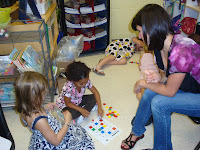
When our journey began with the America's Choice School Design, we implemented internationally benchmarked performance standards. One of the reading standards included students reading 25 books a year. The standard, supported by research that students need to read one million words a year to be proficient grade level readers, was immediately embraced. However, before the implementation of the standard or the kick off event with students and parents, there was much discussion. How many minutes should a student read in one day to attain this standard? How much of the reading would be done at school and how much at home? Would we count books read aloud to students or just books they read independently? What systems would be in place to hold each student accountable? How would we reward students that successfully accomplished the goal?
As we set forth, in the early years, toward our 25 book campaign, we had each student keep a reading log, and some teachers had students respond to each book. (I know, it makes me cringe to say it aloud, too.) And, as the years passed, we continued discussion on the purpose of the standard and got further from responses and closer to the heart of the standard--a student's avid reading.
Now, ten years later, I still have a teacher or two that asks me each year whether reading logs are required, and if they are, what we expect to be included as part of the reading log. I know if they ask me the question, they've only implemented out of compliance rather than commitment and are still grappling with the true purpose. Whenever I'm asked, I think about myself as an avid reader. Presently, I don't have a reading log and I've read so many titles and authors that I'm beginning to accidentally purchase the same books twice, especially if I'm ordering on-line. I know, now, that it's time for me to keep a primitive book log, one where I record the date, title, and author, just so I have a record. Of course, for my purpose it will be a book log that travels with me forevermore.
Lucy Calkin's, in A Guide to the Reading Workshop explains,
The reading log is used to analyze trends in a child's reading and share celebrations. If a teacher wants to give next steps, Lucy suggests, "The conversation needs to occur far from any discussion of the written record." Accurate data keeping is needed in the student's log so it displays an accurate picture of the reader. If the reading log becomes the checking spot of a conference, then fabricated data may become the norm.
As we set forth, in the early years, toward our 25 book campaign, we had each student keep a reading log, and some teachers had students respond to each book. (I know, it makes me cringe to say it aloud, too.) And, as the years passed, we continued discussion on the purpose of the standard and got further from responses and closer to the heart of the standard--a student's avid reading.
Now, ten years later, I still have a teacher or two that asks me each year whether reading logs are required, and if they are, what we expect to be included as part of the reading log. I know if they ask me the question, they've only implemented out of compliance rather than commitment and are still grappling with the true purpose. Whenever I'm asked, I think about myself as an avid reader. Presently, I don't have a reading log and I've read so many titles and authors that I'm beginning to accidentally purchase the same books twice, especially if I'm ordering on-line. I know, now, that it's time for me to keep a primitive book log, one where I record the date, title, and author, just so I have a record. Of course, for my purpose it will be a book log that travels with me forevermore.
Lucy Calkin's, in A Guide to the Reading Workshop explains,
" The log is a record of the book title, the level, the date, the reading place
(home or school), the page at which reading began and the page at which reading
ended, and the minutes spent reading. At the start of each reading workshop,
children pull out their reading logs and record the page number at which they'll
start the day's reading, and they record the start time. Then, at the end of the
reading time, readers record the number of total minutes spent reading and the
number of pages read. As a teacher moves about the room, this makes it easy to
notice that in, say, seventeen minutes of reading time, a particular reader may
have read fifteen pages (which is what you'd expect) or four pages (which would
lead you to want to do some further research). Children, as well as teachers,
study the data.
The reading log is used to analyze trends in a child's reading and share celebrations. If a teacher wants to give next steps, Lucy suggests, "The conversation needs to occur far from any discussion of the written record." Accurate data keeping is needed in the student's log so it displays an accurate picture of the reader. If the reading log becomes the checking spot of a conference, then fabricated data may become the norm.
With Lucy's explanation, you can quickly see that the reading log is used to inform instruction, as well as discuss books with children. What it is not, is a record tool to simply hold students accountable.
Teachers, I'd love to hear your thoughts about reading logs. Do you use them in your classroom? And, how do you feel about them?
 Lucy Calkin's
Lucy Calkin's 














